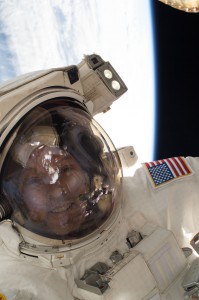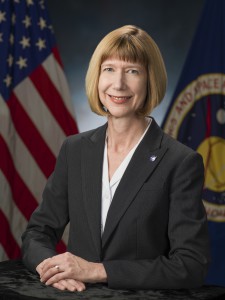 Yesterday, Steve Swanson shared his view of Earth from outside the International Space Station. See if you can view the station from where you are by visiting http://spotthestation.nasa.gov/. Viewing opportunities today include 9:30 p.m. EDT over Orlando, Fla., 8:27 p.m. CDT over Houston and 7:59 p.m. PDT over San Diego, Calif.
Yesterday, Steve Swanson shared his view of Earth from outside the International Space Station. See if you can view the station from where you are by visiting http://spotthestation.nasa.gov/. Viewing opportunities today include 9:30 p.m. EDT over Orlando, Fla., 8:27 p.m. CDT over Houston and 7:59 p.m. PDT over San Diego, Calif.
Kathy Lueders, In Her Own Words
Do you want to learn more about Kathy Lueder’s, the new Commercial Crew Program manager? Here’s the latest interview with her:
Kathy Lueders Named CCP Program Manager
NASA has selected Kathy Lueders as program manager for the agency’s Commercial Crew Program (CCP). Lueders has served as acting program manager since October 2013. She will help keep the nation’s space program on course to launch astronauts from American soil by 2017 aboard spacecraft built by American companies.
“This is a particularly critical time for NASA’s human spaceflight endeavors as the Commercial Crew Program enters into contract implementation,” said William Gerstenmaier, associate administrator for NASA’s Human Exploration and Operations Mission Directorate at NASA Headquarters in Washington. “Kathy’s experience and leadership skills developed during the ISS commercial resupply contract activity will be critical to safely and effectively leading commercial crew transportation activities for NASA.”
Read details here.
SpaceX: Forward Innovations
Space Exploration Technologies, better known as SpaceX, is one of four NASA partners working with the agency’s Commercial Crew Program to develop new capabilities to transport people to low-Earth orbit. Ultimately, NASA intends to certify and use commercial systems to fly astronauts from the United States to the International Space Station and back. Click here for a printable version of this poster.
Sierra Nevada Corporation: Forward Innovations
Sierra Nevada Corporation is one of four NASA partners working with the agency’s Commercial Crew Program to develop new capabilities to transport people to low-Earth orbit. Ultimately, NASA intends to certify and use commercial systems to fly astronauts from the United States to the International Space Station and back. Click here for a printable version of this poster.
The Boeing Company: Forward Innovations
The Boeing Company is one of four NASA partners working with the agency’s Commercial Crew Program to develop new capabilities to transport people to low-Earth orbit. Ultimately, NASA intends to certify and use commercial systems to fly astronauts from the United States to the International Space Station and back. Click here for a printable version of this poster.
Blue Origin: Forward Innovations
Blue Origin is one of four NASA partners working with the agency’s Commercial Crew Program to develop new capabilities to transport people to low-Earth orbit. Ultimately, NASA intends to certify and use commercial systems to fly astronauts from the United States to the International Space Station and back. Click here for a printable version of this poster.
Partners Thrive on Innovations
Improved manufacturing techniques, simplified control systems and cutting edge computers are some of the advancements industry partners of NASA’s Commercial Crew Program plan to employ to make their missions successful. This week, we’ll show you some of the notable innovations that each of the CCP partners have included in their designs up to this point in their own efforts to make spaceflight safe, reliable and cost-effective. NASA’s role in this is to offer expert advice drawn from 50 years of experience.
Live From Space

Astronauts today routinely conduct live interviews with Earthbound students and reporters from orbit aboard the International Space Station, but that was not always the case. NASA astronauts did not broadcast anything live from space for the Mercury or Gemini programs. The first Apollo mission changed that, however, and the Apollo 7 crew of Wally Schirra, Donn Eisele and Walt Cunningham showed the way to conduct a live show in a tradition that eventually included showing the first landing and steps onto the moon and then daily life aboard NASA’s first space station, Skylab. Shuttle astronauts spent considerable time on the flight deck in front of a camera to detail for viewers and chroniclers what it meant to work in space on some of the most sophisticated missions undertaken. Future audiences will see astronauts emerge from Commercial Crew vehicles into the space station. Check out the giant leap that broadcast quality has seen from Apollo 7’s October 1968 transmission to those seen today from the space station.
CCP @ 3: Happy Birthday!
Light the candles because NASA’s Commercial Crew Program is three years old! The past three years have seen CCP and its industry partners make huge strides toward crewed spaceflight. The by-no-means-complete highlights include, from left, Blue Origin’s testing of its BE-3 engine, Boeing’s software evaluations using its new CST-100 simulator, Sierra Nevada Corporation’s glide tests of the Dream Chaser and parachute drop tests conducted by SpaceX. There is plenty of work to be done before any of them make their first flights with people on board, but the time to that milestone gets shorter every day.









